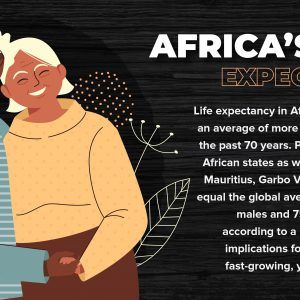Life expectancy in Africa has doubled to an average of more than 63 years, over the past 70 years. Populations in North African states as well as in Seychelles, Mauritius, Garbo Verde and Bostwana equal the global average of 71 years for males and 75 years for females, according to a report. That has big implications for a continent with a fast-growing, youthful population.
By Seth Onyango, bird story agency
With a median age of 25, Africa's population— already the youngest in the world— will also see people living longer as more Africans adopt healthier lifestyles, boost incomes, and access better education.
Recent Statista figures show that for those born in 2021, the average life expectancy at birth across Africa was 63 years for males and 66 years for females.
It is a significant leap from 1950 when it topped a mere 36 years, with the African Development Bank (AfDB) now projecting that life expectancy in the continent to edge up over 70 years by 2050— though not without sub-regional variations.
“Maternal mortality ratio — although still high in comparison to other world regions— decreased from 708 per 100,000 live births in 1990 to 415 per 100,000 live births in 2010, supported by declining fertility rates and greater access to contraceptives,” says AfDB.
“While Africa has made steady improvements over recent decades, it remains the global region with the lowest average life expectancy and highest mortality ratios.”
African elders and pre-elders are also increasingly more likely to be in the workforce, especially women, as states raise the retirement age from 50 years or 55 years in some countries to 60 or 65 years.
According to Statista, Africa’s Human Development Index rating has increased dramatically from 0.375 to 0.498 between 1980 and 2011, demonstrating an improvement in quality of life and as a result greater access to vital services that allow people to live longer lives.
“One such improvement has been successful efforts to reduce the rate of aids infection and research into combating its effects. The number of new HIV infections across Africa has decreased from around 1.3 million in 2015 to 970,000 in 2019,” it says.
Improved life outcomes in Africa come as states make deliberate efforts to boost healthcare, improve the economy to create jobs, and expand social safety nets for the elderly.
According to UNCTAD, poverty levels have declined in most African countries: on average, the proportion of African households with a consumption level below the 1.9 US dollars/day poverty line declined from 40 per cent in 2010 to 34 per cent in 2019.
At below 3.2 US dollars/day, the poverty rate fell from 63 per cent to 59 per cent, and at below 5.5 US dollars/day, it fell from 83 per cent to 80 per cent.
Trade is also expected to spur the next level of growth on the continent as states ratchet up efforts to make Africa one solid trading block.
Statistics show, that in 2019, Africa accounted for 2.8 per cent of world trade, with its intraregional trade accounting for only 4.4 per cent of total continental trade.
Africa’s extra-continental exports reflect a heavy dependence on primary commodities, making the continent vulnerable to external shocks such as global demand and volatile commodity prices.
That is changing as more investment pours into African manufacturing, from electric car batteries to cocoa.
UNCTAD figures show the share of processed goods in extra-continental exports is low at 17 per cent. In contrast, 41 per cent of intra-African trade is comprised of processed goods, suggesting higher potential benefits from greater regional trade for transformative and inclusive growth.
“Deeper regional integration has the potential to generate more opportunities to climb the technological ladder than extra-continental exports, as intra-African exports are technologically more advanced, as indicated by a larger share comprising medium and high technology manufactures,” the UN trade outfit states in part.
“On one hand, the AfCFTA is expected to increase trade through tariff liberalization and the removal of non-tariff barriers, and on the other hand, the AfCFTA is expected to attract investment to build productive capacities, increasing Africa’s supply to serve the rising regional demand.”
UNCTAD asserts that tackling intra-regional trade barriers, such as trade frictions from non-tariff measures (NTMs), regional infrastructure gaps and inadequate market information, can unlock an additional 21.9 billion US dollars in the short term.
This includes 8.6 billion US dollars of untapped trade potential that can be realized through tackling current market frictions, regional infrastructure gaps and inadequate market information.
An additional 13.3 billion US dollars in untapped export potential will be driven by GDP and population growth, which are expected to translate into increased supply and demand within the next five years.
Also Read: African Businesses Power Above Media Pessimism
bird story agency





